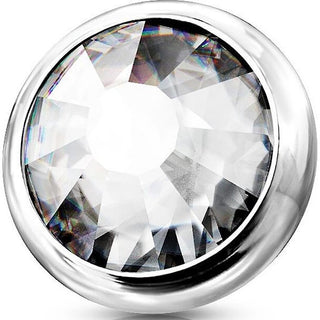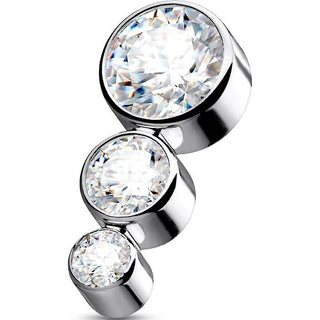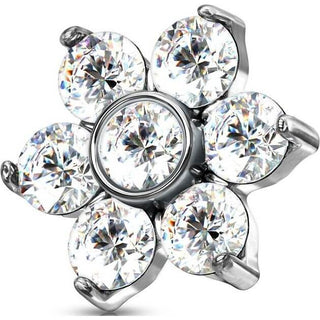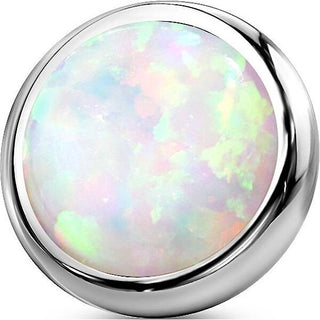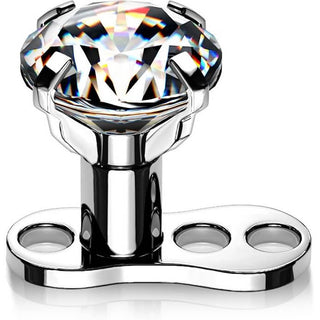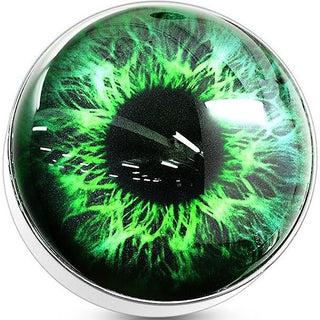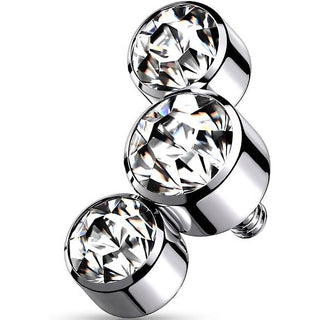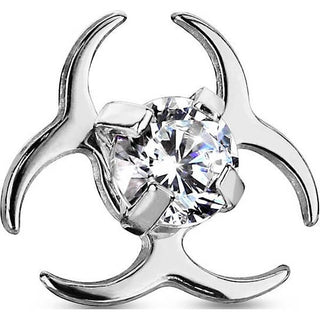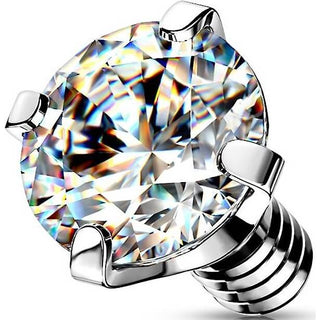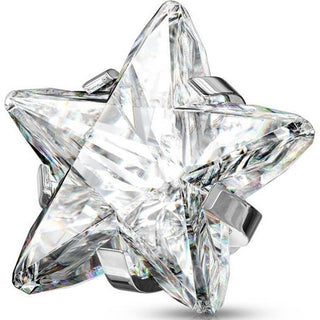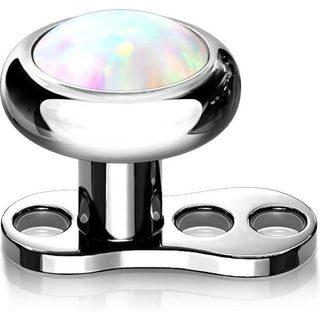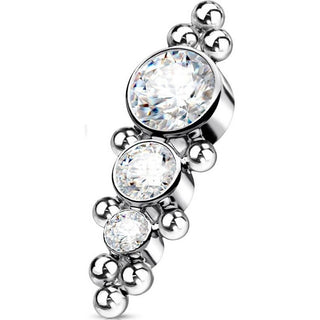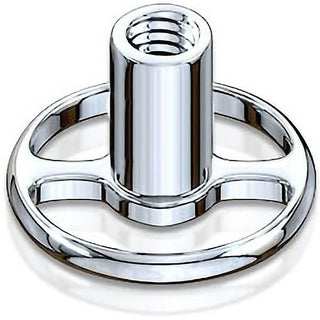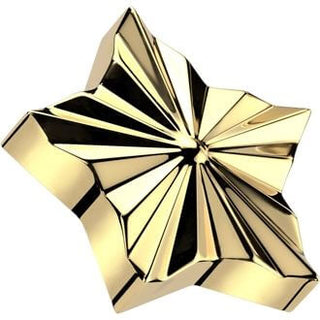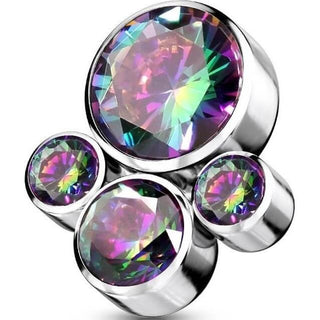Dermal Anchor Piercing
Discover over 50 Dermal Anchor Piercing products at unbeatable prices! Our range includes Titanium and 316L Surgical Steel materials. Experience our exceptional customer service today.
Dermal Anchor
Den Dermal Anchor, och Microdermal genannt, ass eng innovativ Aart vu Piercing, déi benotzt ka gi fir bal all Deel vum Kierper ze verschéineren. Dës Aart vu Piercing ass en Implantat, dat ënner der Haut plazéiert oder verankert gëtt. Dofir gëtt et dacks Dermal Anchor genannt. Well Dermal Anchor kee Ausgangspunkt hunn, gi se och Single Point Piercings genannt. Den Dermal Anchor Piercings ass op bal all Kierperdeel méiglech, et gëtt keng Limite fir d'Fantasie. Plazen wéi Gesiicht, Hals oder Taille, déi virdru fir Piercing ongeeignet waren, kënnen elo mat dëser Method mat all Zuel vu Piercings dekoréiert ginn.
An eisem Shop gëtt et eng grouss Auswiel u Dermal Anchor Usätz a verschiddene Stiler a Motiver. Egal ob einfach Usätz a verschiddene Faarwen oder glitzernd Highlights, mir bidden fir all Preferenz de richtege Schmuckstéck. Eenzegaarteg Formen wéi Sonn, Blummen oder Mound Usätz ginn Iech e spezielle Glanz. Héich poléiert Usätz schafen e eleganten Look. Fannt hei an eisem praktesche Guide all wichteg Informatiounen iwwer Piercing Schmuck, Piercing, Pfleeg an d'Risiken vun engem Dermal Anchor.
Populär Kierperdeeler fir Dermal Anchor
Och wann Dermal Anchor op bal all Kierperdeel plazéiert kënne ginn, sinn e puer Kierperdeeler fir dës speziell Aart vu Piercing besonnesch favoriséiert. Dës enthalen zum Beispill d'Gesiicht an den Dekolleté. Am Gesiicht ginn Dermal Anchor dacks benotzt fir d'Aen an d'Wangenknochen ze betounen. D'Dermal Anchor gi ronderëm d'Aen an d'Wangenknochen plazéiert. Méi Dermal Anchor kënne niewenteneen plazéiert ginn, fir d'Géigend ze ënnersträichen.
Dermal Anchor ginn och dacks um Dekolleté an um Hals plazéiert. Erëm, méi Dermal Anchor, déi laanscht de Schlësselbeen plazéiert sinn, betounen den Dekolleté op eng aussergewéinlech Manéier.
Dermal Anchor kënne och ënner der Haut an all méigleche Konstellatiounen plazéiert ginn. Zum Beispill kënne méi Dermal Anchor benotzt ginn, fir Formen wéi Dräieck oder Stären op der Haut ze bilden. De Look vu méi Dermal Anchor an enger symmetrescher Linn, déi de Kierperdeel ënnersträicht an ervirhieft, ass besonnesch populär.
Dermal Anchor kënne benotzt ginn, fir net nëmmen eenzel Kierperdeeler ze betounen, mä och Tattoen. Den Dermal Anchor gëtt an den Design vum scho geheelte Tattoo integréiert an gëtt dem Tattoo sou e spezielle Touch.
E puer Kierperdeeler, wéi d'Hand oder d'Fanger, si populär, mä net recommandéiert fir Dermal Anchor. D'Hänn si konstant a Bewegung a kommen dacks a Kontakt mat Keimen an Dreck. Dëst mécht d'Heelung méi schwéier a erhéicht de Risiko, sech mam Kierperschmuck ze verfänken. Zousätzlech kann den Dermal Anchor méi séier erauswuesse wéi op anere Plazen. Hautberäicher, déi duerch enk Kleeder wéi BHs stännegem Reiwung ausgesat sinn, sinn och net recommandéiert.
Dermal Anchor Usätz
E Dermal Anchor besteet aus zwee Deeler: eng kleng, länglëch Titanplack, déi an der Haut verankert ass, an en Dermal Anchor Usatz, deen op d'Plack geschrauft gëtt. Dofir gëtt et e vertikale Fuedem op der Plack, un deen den Usatz befestegt gëtt. Am Géigesaz zu anere Piercings kann en Dermal Anchor nëmme mat engem internen Fuedem zougemaach ginn, well d'Plack mat engem internen Fuedemstaark ënner der Haut ausgestatt ass. Dëst ass am meeschte sanft fir d'Piercingplaz, well bei der intern gefiedert Staark d'scharf Rillen op der Innere sinn, während op der Äussewerdeg Säit nëmmen déi glatte Uewerfläch vum Staark mat der Haut a Kontakt kënnt. Sou kann den Dermal Anchor Piercing besser heelen.
An eisem Shop fannt Dir vill verschidde Dermal Anchor Usätz, déi mat hire spezielle Motiver a Formen den Dermal Anchor Piercing zum Highlight vun Äre Piercings maachen. Formen wéi Sonn, Mound, Blëtz oder Schnéiflacken schafen e eenzegaartege Look. Usätz a Form vu Spikes, Kugelen oder Kuppelen sinn eng Alternativ zu einfachen, ronnen Usätz. Blummen- a Stärenusätz mat glitzernden Zirkonia Piercing oder Opal Piercing Steng verschéineren all Kierperdeel. Dermal Usätz mat Motiver wéi Kugele vun Patronen oder dem Biohazard Symbol stiechen aus der Mass eraus a bidden e schéine Look.
D'Staarkendick vun Dermal Anchor Usätz ass normalerweis ongeféier 1,2 mm - 1,6 mm, wärend den Duerchmiesser vun den Usätz ongeféier 2 mm bis 6 mm an d'Héicht ongeféier 3 mm ass. Déi méi kleng Gréissten si bekannt als Microdermals.
Mat eise praktesche Verlängerungsstäck fir Dermal Anchor kann den Ofstand tëscht Haut an Usatz vergréissert ginn. Dëst kann e Virdeel sinn, besonnesch bei frësche Dermal Anchor, well et genuch Plaz fir z.B. Schwellungen schaaft. Eng aner Funktioun vun der Dermal Anchor Verlängerung ass, datt Usätz mat verschiddene Staarkendécke mat Hëllef vun der Verlängerung an de Fuedemstaark vun der Plack passen.
Duurch d'Benotzung vun eisem Dermal Anchor Retainer, kann den Dermal Anchor och an onpassende Situatioune wéi op der Aarbecht gedroe ginn. Déi transparent Retainer maachen de Single Point Piercing bal onsichtbar, wat heescht, datt en an esou Fäll net muss ewechgeholl ginn. Besonnesch well d'Ewechhuele vun dëser Aart vu Piercing net sou einfach ass.
Wärend d'Dermal Anchor Plack nëmmen aus dermalem Titan Piercing gemaach gëtt, kënnen d'Dermal Anchor Usätz aus ville verschiddene Materialien gemaach ginn. D'Usätz si meeschtens aus 14 Karat Gold Piercing, Titan Piercing oder Chirurgesche Stol Piercing gemaach. All dräi Materialien hunn hir Virdeeler. Titan ass besonnesch allergiëfrëndlech a bitt e héije Tragekomfort. Chirurgesche Stol rostet oder tarnéiert net. 14 Karat Gold ass e héichwäertegt a haltbar Material, dat Iech strahle léisst.
Asetzen an Ewechhuelen vun engem Dermal Anchor
Dat Asetzen vun engem Dermal Anchor Implantat ass e bësse anescht wéi Piercings vun engem traditionelle Piercing. Nodeems d'Haut grëndlech desinfizéiert gouf, gëtt d'Géigend markéiert a liicht masséiert, fir d'Gewebe ze léisen. Den Dermal Anchor kann op zwou verschidde Weeër an der Haut verankert ginn. Bei der éischter Method gëtt mat enger Nadelklinge e klengt Lach an der Haut gemaach an duerno gëtt d'Dermal Anchor Plack an d'Lach agefouert. Bei der zweeter Method gëtt e Dermal Punch benotzt, fir d'Haut op der gewënschter Plaz auszestanzen an ongeféier 1,5 mm - 2 mm Haut gëtt ewechgeholl. Dëst schaaft eng kleng Hauttasche, an déi d'Plack agefouert gëtt.
D'Dermal Anchor Plack besteet aus engem Fuedemstaark an dräi Lächer. D'Lächer suergen dofir, datt d'Plack während der Heilung mam Gewebe zesumme wuesse kann. Dëst suergt fir e festen Halt an der Hauttasche.
Am Géigesaz zu normalen Piercings muss de Piercer och fir d'Ewechhuele vun engem Dermal Anchor besicht ginn. Well en Deel vum Piercing ënner der Haut läit, kann en Dermal Anchor net einfach vum Piercer ewechgeholl ginn. Fir dëst ze maachen, mécht de Piercer e klengen Schnëtt mat engem Skalpell an hëlt d'Plack esou eraus. Och den Austausch vun Dermal Anchor Usätz sollt nëmmen vum Piercer gemaach ginn. Dëst ass well beim Austausch, den Usatz an de Fuedemstaark mat spezielle Zangen gegraff solle ginn, well de Staark flaach géint d'Haut läit.
Beim Asetzen vun enger Dermal Anchor Plack kann et e bësse méi bléien wéi bei anere Piercings. Och wann dat ganz schmerzhaft ka ausgesinn, gëtt d'Intensitéit vum Péng vun de meeschte Leit als niddreg bis moderéiert ugesinn. Wann den Dermal Anchor Piercing op der Plaz an der Haut ass, sollt och net vill Péng sinn. Wann Dir Iech fir eng Betäubung entscheede, wäert de Péng nach manner sinn.
Dir kënnt erwaarden, tëscht 60€ an 90€ fir e Dermal Anchor Piercing ze bezuelen. Zousätzlech ginn et Käschte fir d'Ewechhuele vum Dermal Anchor. Jee no Regioun, déi meescht Studios berechnen tëscht 15€ an 30€ fir d'Ewechhuele vum Anchor.
Pfleeg an Heilung
D'Duerchschnëttsheilungszäit fir Dermal Anchor ass ongeféier 3 Méint. De Kierperdeel an d'Uewerflächspannung spillen och eng Roll. Allgemeng heelen Beräi mat wéineg Bewegung a Drock méi séier.
Fir eng onkomplizéiert Heilung soll den Dermal Anchor , wann méiglech, net beréiert ginn. D'Pfleegprozedur ass am Fong déiselwecht wéi bei klassesche Piercings. An den éischten zwou Wochen gëtt den Dermal Anchor mat engem Plaster fir ongestéiert Heilung bedeckt. An dëser Zäit soll den Dermal Anchor zweemol am Dag mat spezielle Piercing-Pfleegprodukter gebotzt ginn. Krust kënne liicht opgeweicht a sanft ewechgeholl ginn. Natierlech sollten d'Hänn virdru desinfizéiert ginn, fir d'Verbreedung vu Keimen ze vermeiden. Wéi bei normale Piercings, sollten Schwämm, Saunen a Solarien fir déi éischt puer Wochen vermeide ginn.
No der Heilung kann den Dermal Anchor mat Zännseid gebotzt ginn. Flossen mécht et méi einfach, tëscht dem Schmuck an der Haut ze kommen, fir Dreck a Hautpartikelen ze entfernen. Beim Un- an Ausdoen vu Kleeder, sollt Dir besonnesch virsiichteg sinn, fir de Kierperschmuck Schmuck net zoufälleg erauszerappen. Beim Sport kann den Dermal Anchor mat engem Plaster bedeckt ginn, fir de Schmuck ze schützen.
Risiken
Ähnlech wéi bei klassesche Piercings, gëtt et och e Risiko vun Entzündungen bei engem Dermal Anchor. Dëst kann duerch Rötung, Schwellung a Péng uginn ginn. Bei Dermal Anchor kann d'Infektioun awer méi liicht enkapsuléieren, well et kee Ausgangspunkt gëtt, wat et manner einfach mécht, Dreck a Bakterien aus dem Stéchkanal ze läschen. Dofir ass eng grëndlech Pfleeg fir d'Heelung essentiell. Wann Entzündung optrëtt, sollt de Piercer direkt konsultéiert ginn.
E weidere méigleche Risiko vum Dermal Anchor ass d'Zoufälleg Ausrippe vum Schmuck. Dëst kann besonnesch geschéien, wann Kleeder onvirsiichteg un an ausgedroe ginn. Normalerweis Bijouen wéi Halsketten kënnen och op engem Dermal Anchor um Hals oder Nacken hänke bleiwen an en esou erausrippen. Dofir sollt een ganz virsiichteg sinn beim Unhuelen vu Kleeder wéi och beim Droen vu Bijouen.
Bei engem Dermal Anchor ass de Risiko, datt de Piercing erauswuesst, vill méi héich am Verglach zu klassesche Piercingaarten. Den Dermal Anchor kann net nëmmen während der Heilung erauswuesse. Eng Oflehnung vum Piercing ass och méiglech no e puer Méint oder Joer no der Heilung.
Grondsätzlech ass d'Haltbarkeet vun engem Dermal Anchor och manner wéi déi vun normalen Piercings mat engem Entrée- an Ausgangspunkt. Wärend e klassesch Piercing theoretesch fir d'Liewen no enger erfollegräicher Heilung gedroe ka ginn, dauert en Dermal Anchor normalerweis nëmmen ee bis fënnef Joer, ier en erauswuesst.
No der Ewechhuele vun engem Dermal Anchor bleift ëmmer eng Narbe, mä dës Narbe ass normalerweis ganz kleng a kann einfach verstoppt ginn. D'Gréisst vun der Narbe gëtt och vun der Methode vum Stéchen beaflosst. Dermal Anchor, déi mat enger Nadel agefouert ginn, hannerloossen méi kleng Narben. Op der anerer Säit, Dermal Anchor, déi gestanzt goufen, hannerloossen am Verglach méi grouss Narben, well en Deel vum Gewebe beim Stanzprozess ewechgeholl gëtt. Am Gesiicht kann esou eng Narbe awer als ganz stéirend empfonnt ginn, onofhängeg vun hirer Gréisst. Aus dësem Grond ass et besonnesch wichteg, d'Entscheedung fir Dermal Anchor am Gesiicht ze huelen, ier se gestach ginn.


